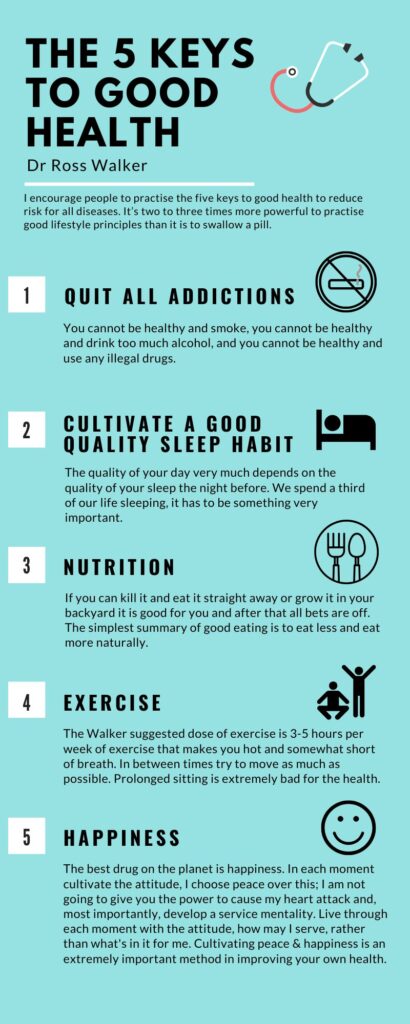How to live to 100
By Dr Ross Walker
As the quest for longevity continues to captivate researchers and the public alike, a growing body of evidence suggests that specific biomarkers can significantly indicate an individual’s potential to reach the impressive milestone of 100 years. Among these, three key biomarkers stand out: telomere length, inflammation markers, and metabolic health indicators.
Telomere length
Telomeres, the protective caps at the ends of chromosomes, play a critical role in cellular ageing. Shortened telomeres are associated with age-related diseases and a decreased lifespan. Studies have shown that individuals with longer telomeres often enjoy better health and a higher likelihood of living into their centenarian years. This finding underscores the importance of lifestyle choices that can preserve telomere length, such as regular physical activity, a balanced diet rich in antioxidants, and stress management. As scientific technology improves, it won’t be too long before measuring telomere length will probably become a normal part of assessment of biologic ageing.
Inflammation
Inflammation is another crucial biomarker in the longevity equation. Chronic inflammation has been linked to numerous age-related diseases, including heart disease and cancer. Elevated levels of inflammatory markers, such as highly sensitive C-reactive protein (hs-CRP) and interleukin-6 (IL-6), can indicate a greater risk of morbidity. Conversely, individuals with lower inflammation levels tend to exhibit better health outcomes and increased longevity.
Lifestyle modifications
Lifestyle modifications, including anti-inflammatory diets and regular exercise, can help manage these markers effectively. Hs-CRP is now a commonly used marker for inflammation, both acute & chronic but should also be used as a non-specific marker for overall health & healthy ageing. A recent study published in the journal “Geoscience” from the Karolinska Institute in Sweden followed the progress of 44,000 Swedes evaluated between 1985 to 1996. Their age ranged between 64 to 99. During this period, 1224 lived to the age of 100.
The key findings from the study were that lifestyle factors were the most important determinant as to whether someone lived to 100. Clearly, picking the right relatives is an important factor as well.

The importance of the five keys to health
Practising the five keys to healthy living has consistently been shown, not only in this report, but in numerous other studies such as the MORGEN trial and the Million Veterans study in the US, not to mention all the evidence from the Blue Zones where people have enormous longevity, that healthy living is the key.
The MORGEN trial demonstrated that practising the 5 keys reduces risk for cardiovascular disease 83%. The Million Veterans study showed that starting the 5 keys from age 40, added 24 extra years of life. The data from the Blue Zones reveals the 5 keys are vital to explain their extraordinary longevity. Interestingly, when people leave the Blue Zones & adopt a more typical modern lifestyle, the mortality & disease rates are the same as their adopted population.
Cholesterol, iron levels and longevity
Interestingly, the Swedish study also looked at biomarkers that can easily be measured in the bloodstream and found the following. Firstly, there was no link to longevity and total cholesterol and iron levels. The key abnormalities were elevated markers in kidney & / or liver function, elevated uric acid & blood sugar levels. These were important indicators of not living to 100.
Metabolic health indicators
Metabolic health indicators, such as insulin sensitivity are essential in assessing longevity potential. Research indicates that individuals with optimal metabolic profiles—characterised by stable blood sugar levels, healthy cholesterol ratios (not total cholesterol levels) and low visceral fat—are more likely to live longer and healthier lives. Therefore, maintaining a healthy weight and engaging in regular physical activity are vital strategies for enhancing metabolic health.
Summary
Telomere length, inflammation markers, and metabolic health indicators are promising biomarkers in the study of longevity. By understanding and optimizing these factors, individuals can increase their chances of living a vibrant, fulfilling life well into their later years.
Yuge Zhang et al, Do people reach 100 by surviving, delaying, or avoiding diseases? A life course comparison of centenarians and non-centenarians from the same birth cohorts, GeroScience (2024). DOI: 10.1007/s11357-024-01330-w
Provided by Karolinska Institutet
